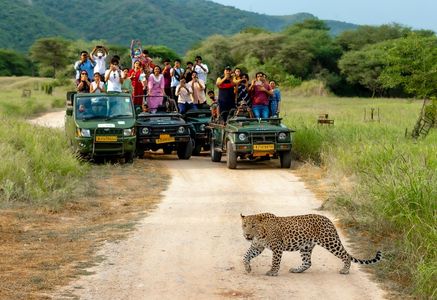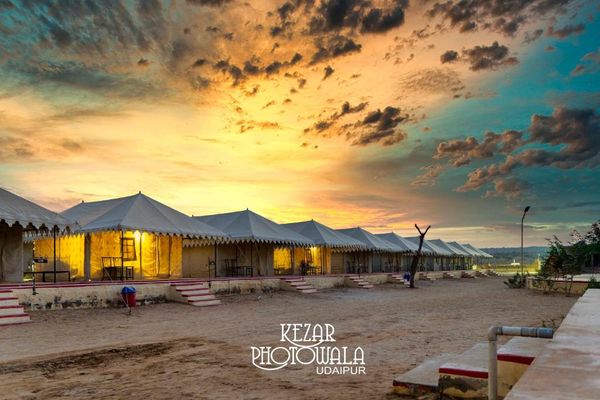Spot the Spots: Your Ultimate Guide to Jhalana Leopard Safari
 Palakshi Meharwal
22 Jul, 2025
10 mins read
329
Palakshi Meharwal
22 Jul, 2025
10 mins read
329

Tucked away in the heart of Jaipur, Rajasthan, the Jhalana Leopard Safari is India’s first leopard reserve situated within a bustling city. Spread over approximately 23 square kilometers, this once-royal hunting ground has transformed into a vital urban wildlife sanctuary. With increasing interest in eco-tourism and big cat sightings, Jhalana stands out as an accessible yet wild destination, making it a must-visit for nature enthusiasts, wildlife photographers, and curious travelers alike.
This comprehensive guide delves into everything you need to know about the Jhalana Leopard Safari—from how to reach, the best time to visit, and what wildlife you can expect, to tips for making the most out of your safari adventure.
What Makes Jhalana Leopard Safari Special?
Unlike larger national parks like Ranthambore or Jim Corbett, Jhalana is known for its remarkably high leopard density. Despite its compact size, the park boasts around 30 to 35 leopards, with 8 to 10 often frequenting the safari zones. This makes the chances of spotting a leopard significantly higher—an exciting prospect for any wildlife enthusiast.
More importantly, Jhalana’s leopards have adapted to the semi-arid terrain and share the landscape with humans, often appearing near temple trails or rocky outcrops. The absence of larger predators like tigers ensures that leopards here are more relaxed, and often active during daylight hours—offering visitors a rare opportunity for sightings.
Location and Accessibility
Jhalana Leopard Safari lies just 10 kilometers from Jaipur International Airport and is well-connected by road. Whether you're staying in the old city or near the newer suburbs, a short drive brings you face to face with wilderness.
How to Reach:
- By Air: The nearest airport is Jaipur International Airport (JAI), approximately 20–30 minutes away by car.
- By Rail: Jaipur Railway Station is 12 km away and has direct trains from Delhi, Mumbai, and other major cities.
- By Road: Jaipur is easily accessible by NH48 and other major highways. Public transport, taxis, and app-based cabs operate frequently within the city.
Safari Timings and Booking Information
Jhalana offers two safari slots daily:
- Morning Safari: 6:15 AM – 9:15 AM (summer), 7:00 AM – 10:00 AM (winter)
- Evening Safari: 3:45 PM – 6:15 PM (summer), 3:00 PM – 5:30 PM (winter)
Each safari lasts for about 2.5 to 3 hours, and bookings can be made through the official Rajasthan Forest Department website or authorized tour operators. Opt for online booking in advance, especially during weekends or holidays, as seats are limited.
Safari Options:
- Gypsy Safari: Accommodates up to 6 people, driven by experienced forest guides.
- Private Safari: Available for exclusive wildlife photography or private groups.
Flora and Fauna in Jhalana Reserve
Although the star attraction is undoubtedly the leopard, Jhalana supports a rich variety of biodiversity.
Key Wildlife:
- Leopard (Panthera pardus): Sightings are frequent, especially near waterholes and rocky outcrops.
- Striped Hyena: Occasionally spotted during evening safaris.
- Desert Fox and Jungle Cat: Often seen in the early morning hours.
- Peacocks, Blue Bulls (Nilgai), Monitor Lizards, and Indian Palm Civets also add to the safari charm.
Birdwatching Haven:
Over 100 species of birds call Jhalana home, including Indian Pittas, Oriental Honey Buzzards, Spotted Owlets, and Shikras. The winter months attract migratory species, making it an ideal destination for birding.
Vegetation:
Jhalana’s vegetation consists of dry deciduous forest, thorny shrubs, and occasional dhonk trees, typical of the Aravalli ecosystem. While not dense, this foliage allows for better visibility—an advantage for wildlife sightings.
Best Time to Visit
The safari operates throughout the year, but certain months enhance your experience:
- October to March: Pleasant weather and migratory birds make this period the best overall time to visit.
- April to June: Summer heat draws animals to water sources, improving chances of leopard sightings, though temperatures can soar.
- July to September: Monsoon brings greenery, but slippery trails may affect safari operations.
Tips for a Memorable Safari Experience
- Arrive Early: Early arrival ensures a better seat, more time with your guide, and a peaceful start to the safari.
- Dress Smartly: Wear earthy or neutral colors to blend into the environment. Avoid flashy attire.
- Carry Essentials: Sunscreen, hats, water bottles, and binoculars enhance the experience.
- Photography Etiquette: Switch off camera flash and maintain silence to avoid disturbing wildlife.
- Listen to Your Guide: The local forest guides are well-trained and know where the animals usually appear.
Conservation Efforts and Sustainable Tourism
Jhalana represents a rare example of successful urban conservation. Local authorities have worked diligently to protect the leopard population and educate the community on coexisting with wildlife. The park’s success has sparked similar initiatives in places like Delhi’s Asola Bhatti and Mumbai’s Sanjay Gandhi National Park.
By adhering to eco-tourism guidelines and choosing certified operators, visitors contribute directly to these efforts. Responsible tourism ensures that future generations can continue to enjoy this wilderness nestled within a rapidly expanding city.
Nearby Attractions to Explore
While in Jaipur, don’t miss the chance to explore other iconic landmarks:
- Amber Fort
- Hawa Mahal
- Nahargarh Biological Park
- Albert Hall Museum
A visit to Jhalana can be seamlessly integrated into a broader Jaipur itinerary, offering a blend of cultural richness and wild adventure.
Final Thoughts
Jhalana Leopard Safari offers a one-of-a-kind opportunity to observe leopards in their natural habitat just minutes from city life. Its high success rate for sightings, combined with ease of access and conservation impact, makes it a standout destination for wildlife lovers. Whether you're a seasoned traveler or a first-time safari-goer, Jhalana promises a thrilling and educational escape into the wild.
Written By:
Palakshi Meharwal



Hotels at your convenience
Now choose your stay according to your preference. From finding a place for your dream destination or a mere weekend getaway to business accommodations or brief stay, we have got you covered. Explore hotels as per your mood.


